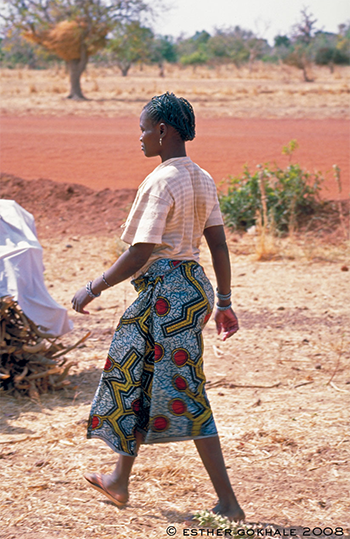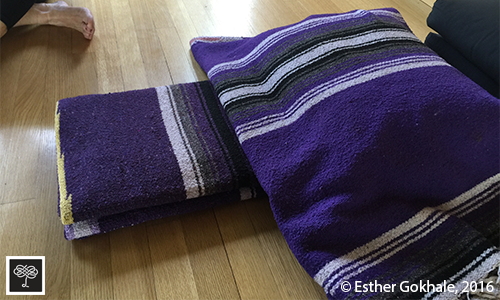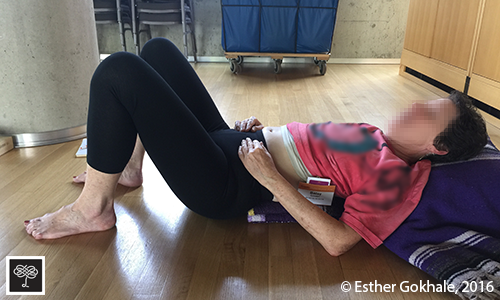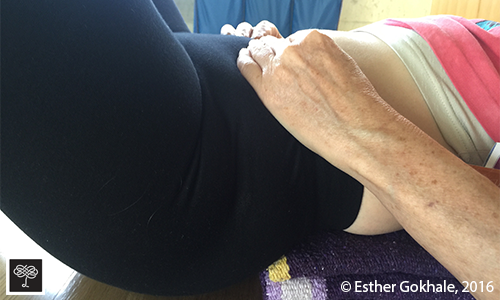Don’t Stick Your Behind Out; It’ll Sway Your Back
My book has a lot of images of village Africans. This is because I travelled to Africa, which is in turn related to the fact that primal posture is better preserved in Africa than in most places, and certainly you find better posture in village Africa than in modern, industrial societies.

This woman’s J-spine is well intact; her L5-S1 curve is pronounced. L5-S1 curve varies by race and social posture influences.
Readers of my book sometimes have the mistaken impression that the work is about replicating the baseline shape of a village African. Though I state explicitly that the amount of L5-S1 curve varies by race and is also very individual, newcomers to our program sometimes believe they should be sticking their bottoms out. Not so! Trying to create L5-S1 curve by sticking your bottom out is likely to cause an undesirable sway higher in the lumbar spine, as L5-S1 tends to be stiffer than the higher lumbar levels.
The goal is not to force a predefined amount of L5-S1 curvature into one’s system, even if it is clear that (as in most cases) there’s been pelvic tucking happening over the years and one’s natural L5-S1 curve would be greater than what’s showing up currently. The way to reintroduce normal lumbosacral (L5-S1) curve is not to tense up the long back muscles (erector spinae muscles). That’s like pressing on the accelerator and the brakes simultaneously. Rather, healthy steps towards re-establishing one’s normal L5-S1 curve are:
Learn to relax rectus abdominis (the “6-pack” muscle) while still cultivating tone. One way to learn to relax a muscle is to first contract it and then release the contraction. For the rectus abdominis, that means first tucking the pelvis, and then let the contraction go.
Toning the gluteal pack (the buttock muscles), including gluteus medius. These muscles, when toned, draw the sacrum backwards, which in turn lends to gluteal action, thus forming a positive feedback loop. The best way to tone the gluteus medius is to use it in walking — make every step a rep. For more instruction in this, refer to the Glidewalking chapter in 8 Steps to a Pain-Free Back. Additionally, our “These Glutes are Made for Walking” blog post has useful visuals about what you want to do and our “Samba Your Way to Beautiful Glutes” blog post describes how to use samba to develop your glutes.
Mobilizing L5-S1 in case it has become stiff from years of tucking the pelvis. My favorite approach for this is to use a roller. While remaining obliquely “seated” on the roller, slowly roll forward and back, keeping the sacrum in contact with the roller. Let the “tail” drop toward the ground when rolling forward, giving the sensation of “wrapping” the sacrum around the roller. Another approach uses a yoga bolster, rolled-up sticky mat, or stack of blankets. We teach this technique in our Foundations Course under supervision of a qualified teacher. (The technique involves using a yoga bolster, rolled-up sticky mat, or blanket stack and allowing the sacrum to hang over the soft, yet firm, edge of the chosen implement. Make the bolster longer with an extension brick or cushion, and use a pillow under the head, neck, and 2” of the upper back, so the upper body is stretchlying.)

Creating a soft, yet firm, edge is an important step for mobilizing your L5-S1 juncture.

Allow the sacrum to hang over the edge of the bolster or other soft yet firm material.
To summarize, a healthy pathway to restore the primal architecture you had as a child is to relax your front, tone your behind, and loosen the link between your back and your bum. Which of these pieces have you made the most progress with?

Comments
Like others before me, I vote
Like others before me, I vote yea for a video of the bolster exercise. Words/descriptions are great when you know what you are doing, but a 'picture' (video) is worth 1000x. ;-)
I do not understand sit
I do not understand sit obliquely on roller. Kindly clarify with a picture.
Add New Comment
Login to add commment
Login